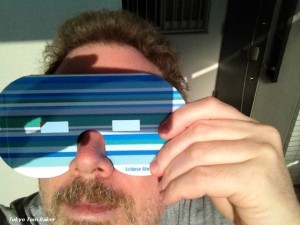Tom Baker (Chiba-ken, 1989-91) is a, coauthor of The Sushi Lover’s Cookbook and Tokyo Chic and contributor to Time Out Tokyo and Time Out Shortlist Tokyo. He blogs as “Tokyo Tom Baker.”
A few minutes ago, I went outside and tested my fancy new eclipse-viewing glasses. Forty-eight hours from now, on the morning of May 21, I’ll be among millions of people in Japan and the western United States taking the rare opportunity to view a “kinkan nisshoku,” or “annular eclipse.”
An annular eclipse is one that occurs when the moon passes between the Earth and the sun at a point in the moon’s orbit when it is far from the Earth and thus appears relatively small – the exact opposite of the effect seen in the recent “supermoon.” In an annular eclipse, this small moon appears superimposed in front of the sun rather than completely blocking it out. The visible portions of the sun form a fiery ring around the moon’s black silhouette.
One positive effect of this event is that it has expanded my vocabulary in two languages. The English word “annular,” which comes from Latin via French, means “ring-shaped.” The Japanese term is even more straightforward and easy to remember, as it is written with a string of kanji characters that literally mean “gold-ring sun-eating.”
The moon’s shadow will fall across a large swath of the Earth, but the full annular effect will be visible only in a narrow band that goes through nearly all of Japan’s major cities (what luck!) Monday morning before moving out to sea in a long arc across the northern Pacific Ocean, where it will slip back to late Sunday as it crosses the International Date Line, after which it will come ashore in northern California, pass over Las Vegas and the Grand Canyon, and finally fade out over the border of Texas and New Mexico.


